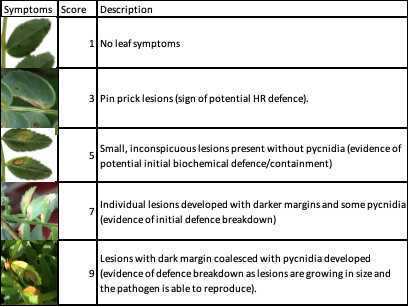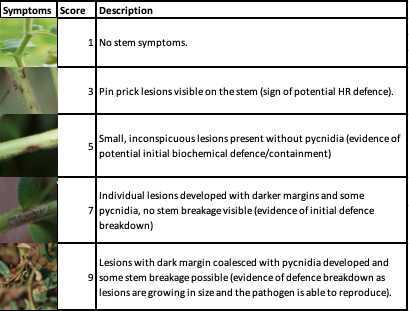Chickpea Inoculation with A. rabiei for Ascochyta Blight Disease Assessment Under Controlled Conditions
Melody Christie, Dr Prabhakaran Sambasivam, Ido Bar
Abstract
This protocol describes the inoculation preparation, bioassay and disease assessment of Ascochyta rabiei isolates on a differential set of chickpea host genotypes.
Steps
Inoculum preparation
Approximately 2 weeks before the planned inoculation date, subculture isolates of A. rabiei onto V8 media agar which contains 30mg/L of antibiotic (Streptomycin/Penicillin 30mg/L ). Add antibiotic after media has been autoclaved and is cool enough to touch (approximately 45°C ). Aseptically place one plug from the original culture in the middle of the plate and incubate at room temperature for 14 days. Include a positive control isolate with each batch per bioassay.
Sowing
Autoclave soil (premium potting mix) before use (one day before sowing). Ensure pots have been cleaned and dried if previously used.
Into a 10 cm diameter pot sow five or six chickpea seeds, being careful not to sow too close to the side of the pot. Sow two pots of each chickpea genotype per isolate so that at least 10 plants can be inoculated. Sow ICC3996 and Kyabra one day earlier than the other genotypes. Fertilise with Osmocote (slow release) at the time of sowing and Aquasol once a fortnight.
Plants are grown under controlled environment conditions at approximately 23°C . When the chickpea plants are all at 4th node stage (or as many as possible without other varieties growing too big) inoculation should occur.
On the day of inoculation saturate the plates with distilled water and leave for 0h 15m 0s.
Using a wire loop or glass rod, gently scrape over the surface of the plate to dislodge spores.
Pour the solution into a 500mLflask (filter through a piece of tissue/gauze if required).
Using a heamocytometer adjust spore concentration to 1*10^5spores per ml in a volume of Transfer suspension to a Preval hand held sprayer and add two to three drops of Tween 20 (0.02% (v/v)) per 100mL of spore suspension. Ensure the sprayer is labelled with the isolate code.
If for some reason the inoculum is not going to be used straight away, it can be placed in the dark in the fridge for a up to 2 hours.
Inoculation
Place pots in groups of 10 (two pots of each genotype). Separate each pot away from the others for the inoculation step. Using a Preval hand held sprayer, spray inoculum onto chickpeas until runoff (approximately 15 - 20 ml per plant) and return to their original position.
Place pots inside the black plastic tubs and leave in dark for 24 hours
24 hours after inoculation remove plants from plastic tubs and place in a tray under grow lights.
Plants are misted until beading forms on leaves every 3 days and watered twice a week (or as required). Disease assessment (phenotyping) occurs after 21 days.



